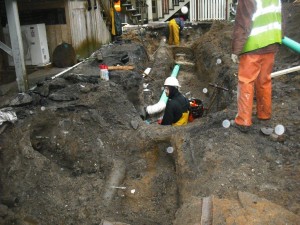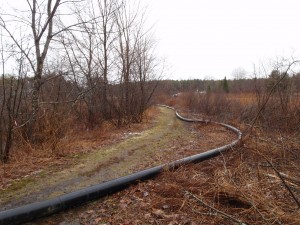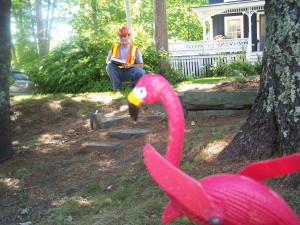February 2012, Vol. 67 No. 2
Features
Social Benefits Of Pipe Bursting: A View From The Field

Editor’s Note: The International Pipe Bursting Association (IPBA), a division of NASSCO, is presenting a series of articles in Underground Construction that will provide the reader with a better understanding of the technology. Many myths and misconceptions exist regarding this proven rehabilitation method for replacing existing underground utilities.
Pipe bursting is a proven and cost-effective method for replacing underground utilities of most conveyance types. Pipe bursting has numerous advantages in comparison to other replacement options, primarily the ability to increase the host utilities size and, in fact, multiple sizes in some cases. This article will focus difficult task of quantifying the social benefits of pipe bursting – from a field perspective.
With increasingly tight municipal budgets being maximized, social benefits are receiving greater and serious consideration. Pipe bursting is performed increasingly more as understanding of its social benefits become more prevalent. Alternative construction methods are generated with social or environment impacts in mind due to their great importance to a projects overall success.

Throughout the history of underground utility replacement social impacts have been a considerable point of attention. The need to accommodate to today’s extremely busy lifestyles is more present than ever. People have increasingly hectic schedules as a relaxed economy and ever increasing costs have pushed the needs for efficiency to unprecedented levels, especially in regards to transit and more particularly vehicular traffic. Pipe bursting significantly reduces detrimental effects of typical construction.
Pipe bursting provides some much needed remedial action to typical open-cut construction schedules and many of open-cut’s negative social impact. Construction activities or having to perform replacements in main corridors or residential neighborhoods provide exposure for adverse social impacts. Whether it’s from back-up beepers, excavation practices or even increased equipment and personnel presence in residential and congested areas, time is of the essence. The public’s patience and overall acceptance to the often inevitable construction impacts tend to wear thin with time and prolonged presence — as would be expected.

Desirable alternative
Having to cross an individual’s driveway, with ample courtesy warning, for a reasonable amount of time during an installation is merely an afterthought when typically an experienced crew with applicable machinery and training will be installing 500 to 1,000 feet of utility per day. That’s in lieu of 100 to 150-feet with typical open-cut in moderately workable conditions. Having a piece of pipe crossing your driveway for one to 4 hours with limited excavation is a small issue compared to the barrage of earth hauling equipment removing and replacing aggregates during a typical open-cut project. Being delayed in traffic in a world of concentrated carbon emission awareness and heavy usage of diesel burning equipment for extended durations discourages rate payers to yearn for significant capital improvement interests. Sitting in backed-up construction traffic, late for an obligation or waiting for muddy dump trucks to back into position for another trip doesn’t get residents thinking they want more infrastructure improvements.
Having the increased production of pipe bursting has often amazed residents to how quickly progress is made, and how the quicker construction makes interruptions manageable. Pipe bursting crews have often received acknowledgment of their social impact awareness, knowing their very existence is based on the premise that social impact to residents is detrimental to their industry’s success. A good example was a pipe bursting crew member of mine carrying groceries for a local resident knowing our presence on the job, in part, was to prevent negative social impact to the residents during our installation.
Safety considerations
When employing the social advantages of pipe bursting, it is essential to delve into the exposures of employees to ever present dangers in underground construction activities, and the relative reduction of such circumstances in pipe bursting construction. Construction workers are more than a simple occupational group: they are dads, moms, sisters and brothers, loved ones to millions of people throughout the world.

Enabling an extreme reduction of their exposure to dangerous and sometimes life-threatening situations cannot be overlooked; yet no numerical value can be established to the value of less trenching, less machinery movement, less pinch points and fewer variables overall that decrease social and occupational risk.
Trench cave-ins have killed thousands and seriously injured personnel due to the numerous exposures during traditional trenching, causing compounded safety risks for workers and the public at large, and all resulting from inadequate trench box placement. Remember this is not driven by employee negligence, but by the approach and the margins. A typical pipe burst layout consists of two small excavations on adjacent ends of the proposed install. These pits are properly constructed with extended presence and proper machine function, which in turn provides a safe work zone for all parties involved. Employees are not constantly being exposed to changing trench conditions.
Social benefits of pipe bursting are plentiful throughout the construction consideration spectrum. Pipe bursting can provide more bang for your buck by keeping employees safer, reducing traffic disruption, providing increased capacity, preserving the environment in sensitive areas, keeping adjacent utilities undisturbed, reducing restoration costs, decreasing carbon footprints and risks associated with disturbing massive quantities of soil, and is also business friendly. Pipe bursting provides residents a great relief to the headaches of typical open-cut construction.
Coming in March: Pipe bursting myths and misconceptions.
FOR MORE INFORMATION:
IPBA (NASSCO), (410) 486-3500, www.nassco.org




Comments